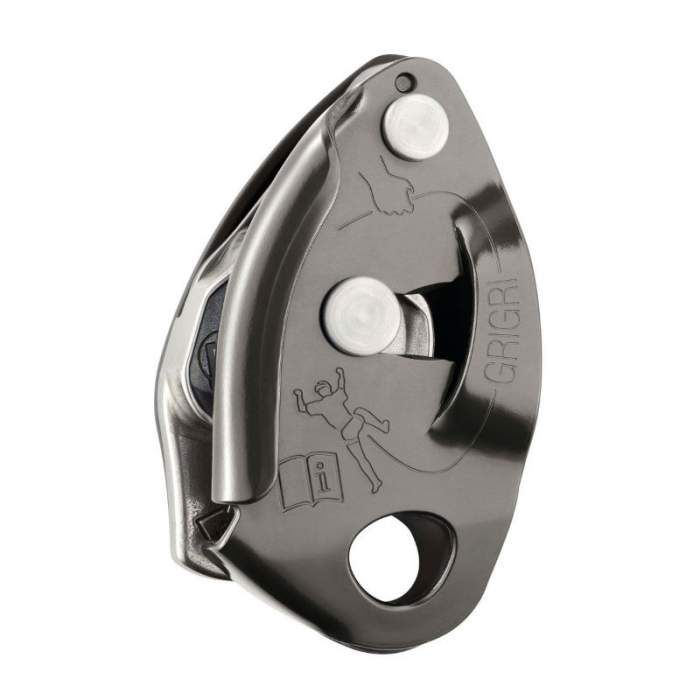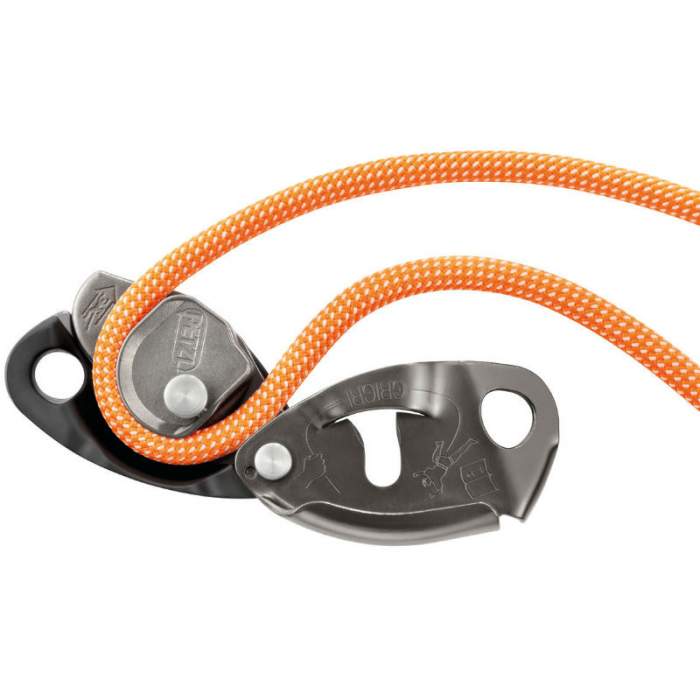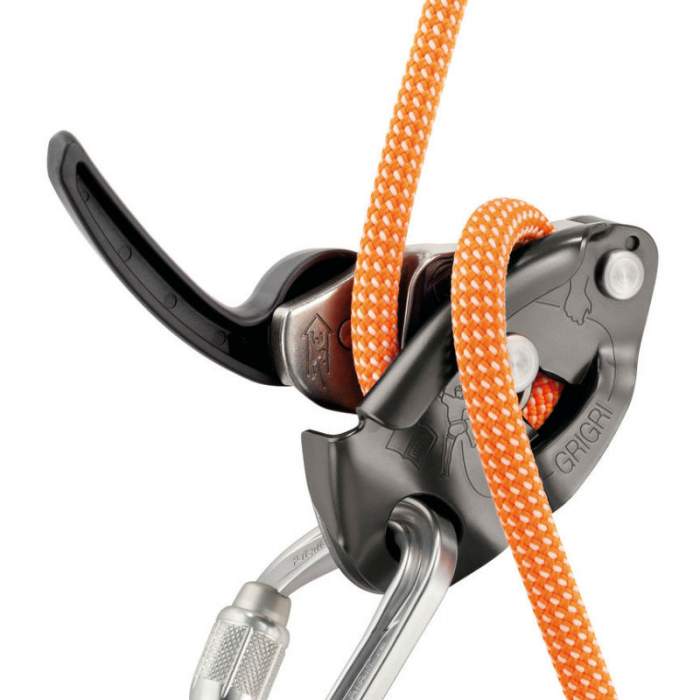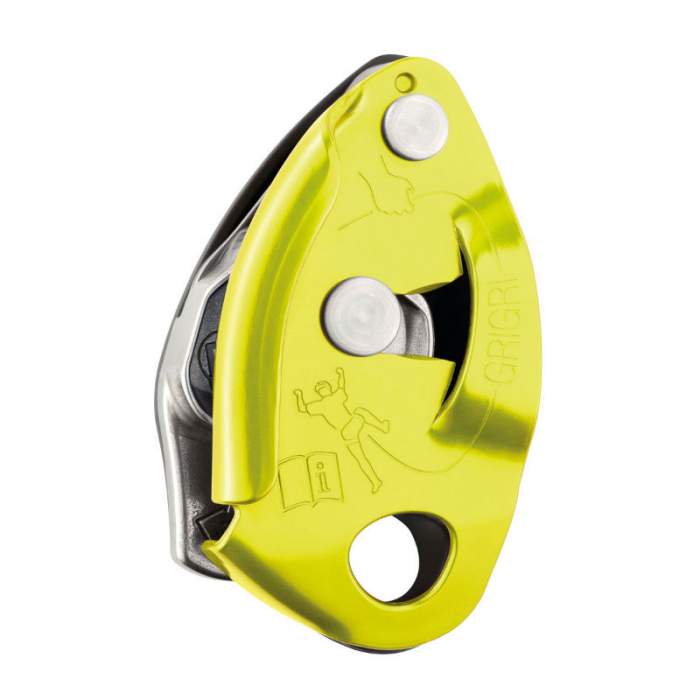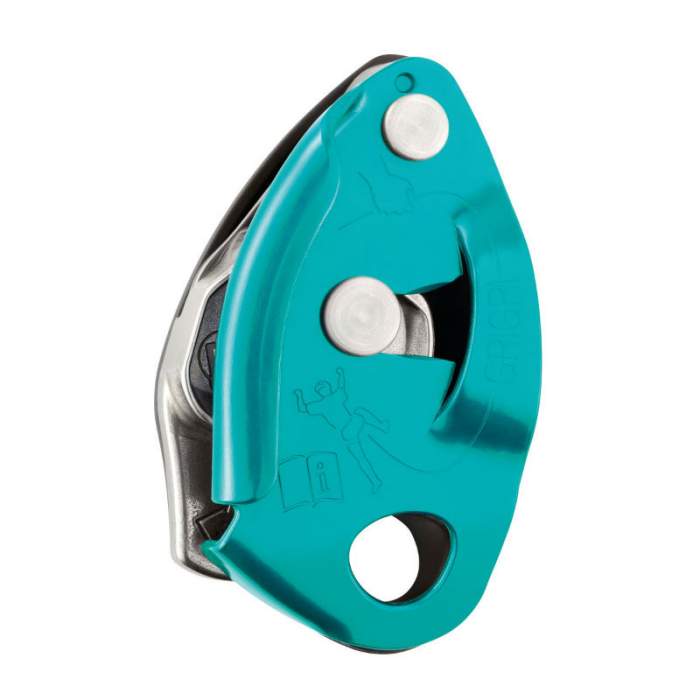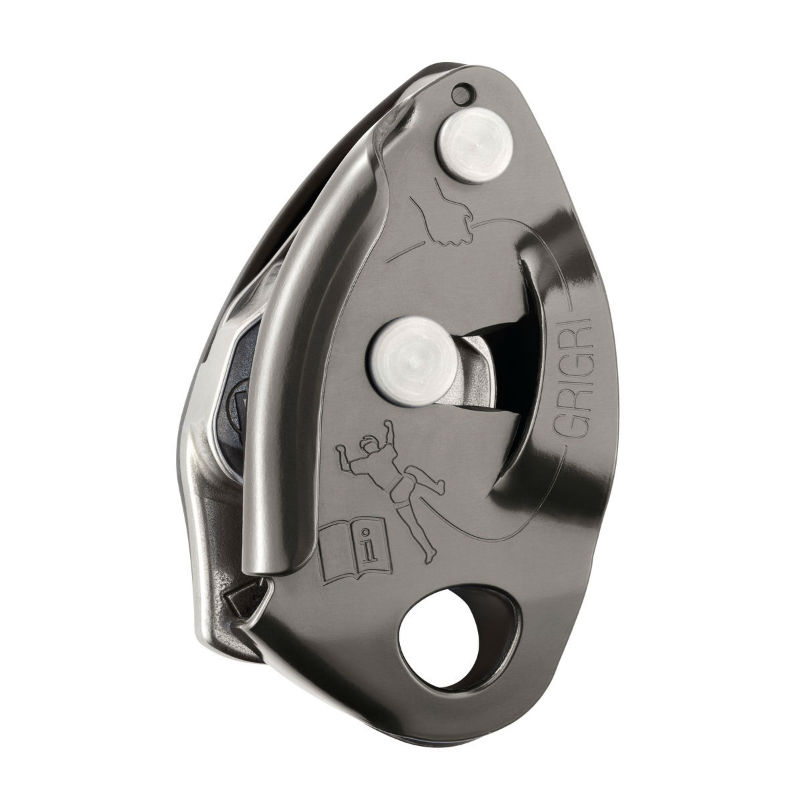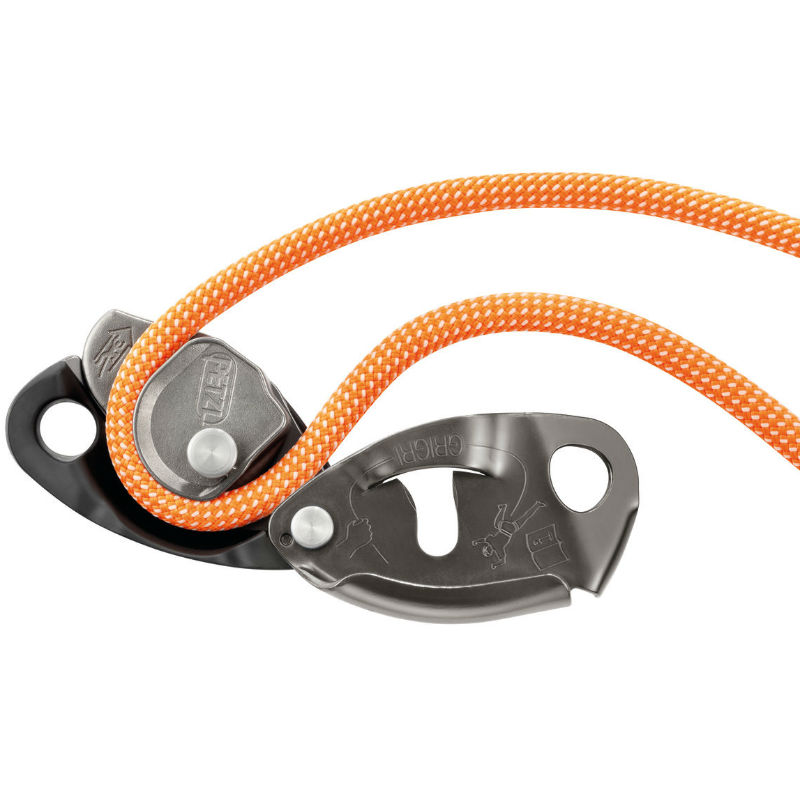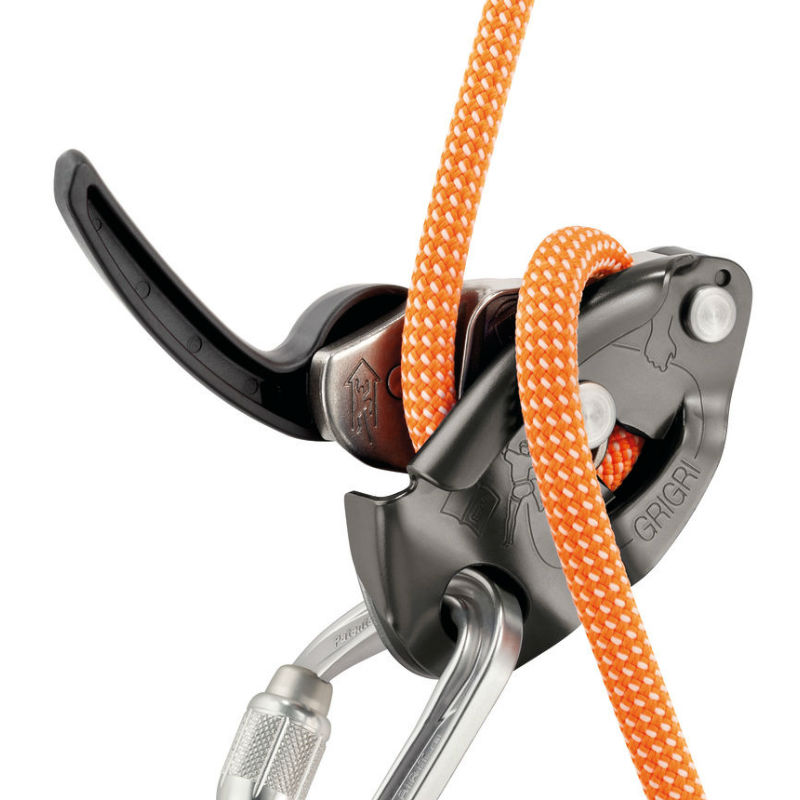GriGri 2
Description
The GRIGRI 2 belay device with assisted braking is designed to facilitate belay maneuvers. The GRIGRI 2 works equally well for lead climbing and top roping. Compact and lightweight, the GRIGRI 2 will accompany you for many years, on climbs all over the world. The GRIGRI 2's design allows for excellent descent control.
Description
Hand motions are the same as with classic belay systems: both hands on the rope. A fall is stopped by gripping the brake side of the rope with your hand.
Assisted braking: during fall arrest, the belayer holds the brake side of the rope, the cam pivots and pinches the rope, increasing the braking action until the rope stops sliding.
The GRIGRI 2's design allows for excellent descent control. One hand holds the rope and the other uses the handle to unlock the cam. The patented handle design allows a very gradual release of the rope. Combined with the strong braking action of the cam, it gives a great feeling of security when lowering a partner or rappelling.
The GRIGRI 2 is compact and very light at 170 g
Built with a stainless steel friction plate and cam to ensure a long life for the product
Diagrams for rope installation engraved on belay device (interior and exterior)
Material(s): aluminum side plates, stainless steel cam and friction plate, reinforced nylon handle.
Retail price
This Product is Hard to Find.
We don’t know where you can buy this item online in the US. We’ll continue to check all the major retailers and will update this page as soon as we find one.
If you know where to find this online in the US, let us know, and we’ll add the link.



Device Type  Device TypeTubeThe most commonly used belay type also called an “ATC” or “tuber.” Other than a distinction between other belay device types, “Tube” is a rarely used term, most climbers just assume you're talking about this style when they refer to your "belay device." 
Figure 8Mostly used in rescue, canyoneering, tactical, work safety, or by old school climbers and rappellers. One reason they went out of popularity with recreational climbers is because they tend to create twists in the rope. 
Brake AssistThese devices assist in stopping the rope when a climber falls or hangs on the rope. 
Often referred to as “auto-blocking” but that’s not the official terminology because no belay device should be assumed to work automatically by itself, even if it feels like it does (or does most the time). PlateWhen simplicity is a must, or you started climbing before Tubers were the norm. Bonus: They tend to be very light weight. 
DescenderFor rappelling, not for belaying a lead climber or top-roping. 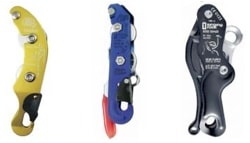 |
Brake Assist - Mechanical |
Weight (g)  Weight (g)In grams, the weight, as stated by the manufacturer/brand. |
170 g |
Belay Brake Assist  Belay Brake AssistThis is when the belay device significantly reduces the amount of holding power the belayer must exert to stop a fall and hold a climber. This is also called "assisted-braking" as the device must hold a significant amount of the climber’s weight; this term does not include friction-adding "teeth" found on some tube style belay devices. Confusingly referred to as “auto-blocking” or “auto-locking” these terms wrongly imply the device will always, automatically, stop a fall or hold a climber even if the belayer/rappeller is hands-free. These devices are not meant to be used without a hand on the braking side of the rope; the belayers/rapppeller brake hand should always be on the brake rope. Worth ConsideringMost of the mechanical brake assist devices only hold a single strand of rope and are not capable of double-strand rappelling (the most common method of rappel). |
Yes |
| Rope Options | 1 rope only |
Guide Mode  Guide ModeThis is when you belay directly off the anchor instead of your harness. Guide mode is helpful if you climb outdoors a lot because it reduces the holding power required from the belayer. When your partner falls or rests, the weight of the climber is held mostly by the anchor and the belay device. Tubers and PlatesWhen belaying in "guide mode," the tubers and plates turn auto-blocking. During a fall, the climbing rope pinches the slack rope, completely stopping the movement of either rope. A common guide mode setup shown below. 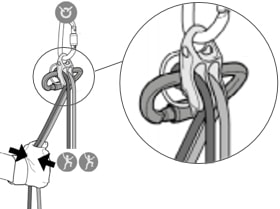
Mechanical Brake Assist DevicesThere is no difference in the functionality of the device. A brake-hand should always be on the rope to ensure the climber is caught in the case of a fall. A common guide mode setup shown below. 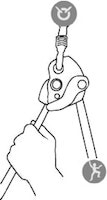
Where guide mode is used
Learn Morehttp://www.climbing.com/skill/essential-skills-auto-blocking-belay-devices/ |
1 follower only |
Teeth  TeethTeeth are only seen on tube devices. They add friction that helps grip the rope for more belaying control. This is helpful for belaying heavier climbers. Teeth are becoming standard on new tube devices. 
Worth ConsideringTeeth do wear out. You can limit wear by rappelling on the side without teeth (if you don’t need the extra friction). Once they’re worn, you’ll still have a usable belay device, just less friction. |
No |
Rope Range (mm)  Rope Range (mm)The range of rope diameters, in millimeters, that the manufacturer/brand specifies can safely be used. This is the best case scenario and does not necessarily take into consideration that certified ropes have a tolerance of +/- .3 mm. Recently, manufacturers have started to add an "optimized" rope range -- this is the range that will result in the nicest handling of the belay device. | 8.9 mm - 11.0 mm , optimized for 9.4 mm - 10.3 mm |
Certification  CertificationsThe main climbing gear certifications are CE and UIAA--and normally the UIAA creates the rules that the CE body also supports. When possible, we try to list all the certifications the product carries. To sell a climbing product in Europe, the device must be CE certified. There are no official requirements to sell climbing gear in the US. The UIAA certification is a voluntary process. Learn MoreRock and Ice Certifications Guide |
CE, EN, UIAA |
The bottom line is the GriGri 2 has an amazing reputation in the climbing scene all over the world. It is a safer option than any tube belay device and it can do things that other belay devices can't. There are other assisted belay devices out there but they are almost all just a knock-off of this device. I highly recommend the GriGri 2.
Despite the high pricetag, GriGris are one of the most popular belay devices in the world. The reasons are many and varied. Its assisted locking mechanism saves you hand strength and, with proper technique, can improve your safety margin. Furthermore, when compared to the other assisted locking models, the GriGri 2 is lighter, smoother, and competitively priced. Although most climbers will still need a secondary device for rappelling two strands, we believe the GriGri 2 is the best device for the most belay applications.
After 20 years of success, Petzl updated the original design in 2011, making it 25 percent smaller and 20 percent lighter than the original version, with the same braking power; the new version, cleverly dubbed the Grigri 2, is also compatible with ropes from 8.9mm to 11mm, to keep up with ever narrowing cords. Of course, the development of a new product coincided with the development of bad habits and climbing accidents due to improper use, so a few years before the release of the Grigri 2, Petzl stepped up its efforts to educate the public on the correct usage through videos and posters hung in climbing gyms.
I took the GRIGRI 2 on two different sport climbing trips, one to Lander and one to Shelf Road. On both trips it logged many vertical feet and lowers, as well as a few whippers by my friends. The device is easy to load and feed rope and when the climber does fall or weight the rope, the cam clamps down and arrests the fall. Unlike other devices, its easy to understand how it works, and that makes it easier to use correctly. As with all these devices, the brake hand still has to always control the rope strand, but it will stop the falls quickly and efficiently for you. Using it while a friend is hang-dogging a route is really where the device shines. You don’t have to keep your hand cranked over, the GRIGRI 2 does the work for you by holding the weight in the cam.
My co-tester, Eddie, made a simple comment about the device: “It feels more like you’re belaying.” It’s true, for whatever reason it feels more like you’re belaying. I think what Eddie was alluding to is that it gives you more control. More control when feeding rope, catching falls, and lowering. Those are the three tasks that the device is designed to accomplish and it accomplishes them better than the old one. Success on Petzl’s part.
The only thing I’d like to add is my impressions on the recommended range of rope diameters for the device. I think that the star rating that Petzl has adopted is a bit misleading for the average user. If stars were awarded for ‘ease of use’ I would bump the recommended range down a bit. My personal opinion is that the device performed flawlessly on the skinny ropes. I would say 9.1 to about 9.8 is going to give the user the greatest ease of use. Even the 10.1 felt just a little tight in the device but perfectly fine. The 10.5 felt outright stiff and jerky though this could also be attributed to the stiffened nylon of a 12-year-old rope. But that is saying something. I haven’t bought a fat rope in 10+ years and had to dig through my closet to find one! With most climbers using a rope in the 9.8 to 10.1mm range this device is going to be flying off the shelves. I would definitely hesitate before buying one if you still climb on an 11mm rope. Overall, a job well done by Petzl and I’ll be buying one as soon as they hit shelves in the U.S. Slated for release, springtime 2011.
We topped out the route with an hour of daylight left, which was just enough to get us down the descent and back to our packs before the perpetual twilight of night time in Vegas set in. The rest of the week was filled with long climbs in the beautiful canyons of Red Rocks, and the GRIGRI2 was a trusty companion on every route.
As we move towards lighter and faster climbing equipment, it is good to see Petzl has not compromised on quality, and has clearly put a lot of research and development into the GriGri 2. After 20 years, ol’ GriGri has manged to up the game, and deliver a belay job that will make your toes curl.
Petzl has discovered that exerting excessive force on the fully extended handle of the GRIGRI 2 can cause internal damage, such that the GRIGRI 2 handle may become stuck in the open position.
If you liked the original Grigri you'll love the new version. Aside from being lighter and smaller and handling thinner ropes, the Grigri 2 just works smoother, like buttah. For a truly seamless belay experience pair it with Petzl's Freino carabiner, harder to find but worth it with a little horn that allows full control for lowering a heavier partner. The good folks at Petzl deserve credit for taking a great product and making it signficantly better, and extra credit for clear instructions that include detailed drawings of usage in various scenarios.
- 1 of 2
- next ›
This video is really long but very informative, first three minutes it shows Petzl athlete's opinion about GriGri 2 and rest shows instruction for using it. A well worth watching video.
- 1 of 2
- next ›
A checklist helping you monitor your GRIGRI 2 Belay Device health, helping to know when to retire your personal protection equipment.

